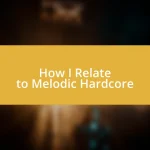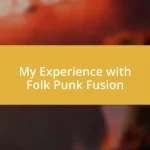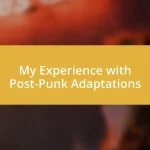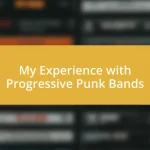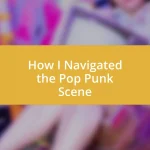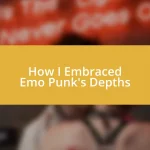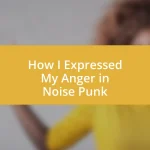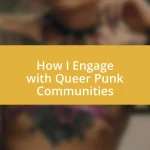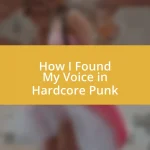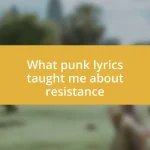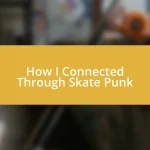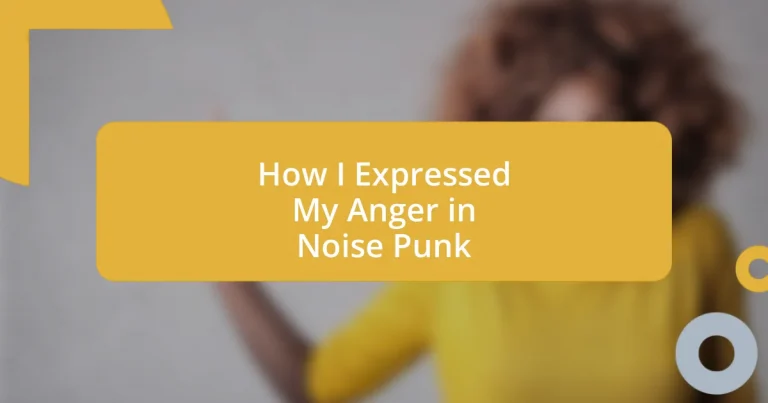Key takeaways:
- Noise punk serves as a powerful emotional outlet, allowing individuals to transform anger and frustration into raw energy and creative expression.
- Performing and engaging with the noise punk community fosters a sense of belonging and shared experience, turning personal struggles into collective empowerment.
- Experiences in noise punk encourage personal growth and resilience, demonstrating how embracing emotions can lead to creativity and self-discovery.
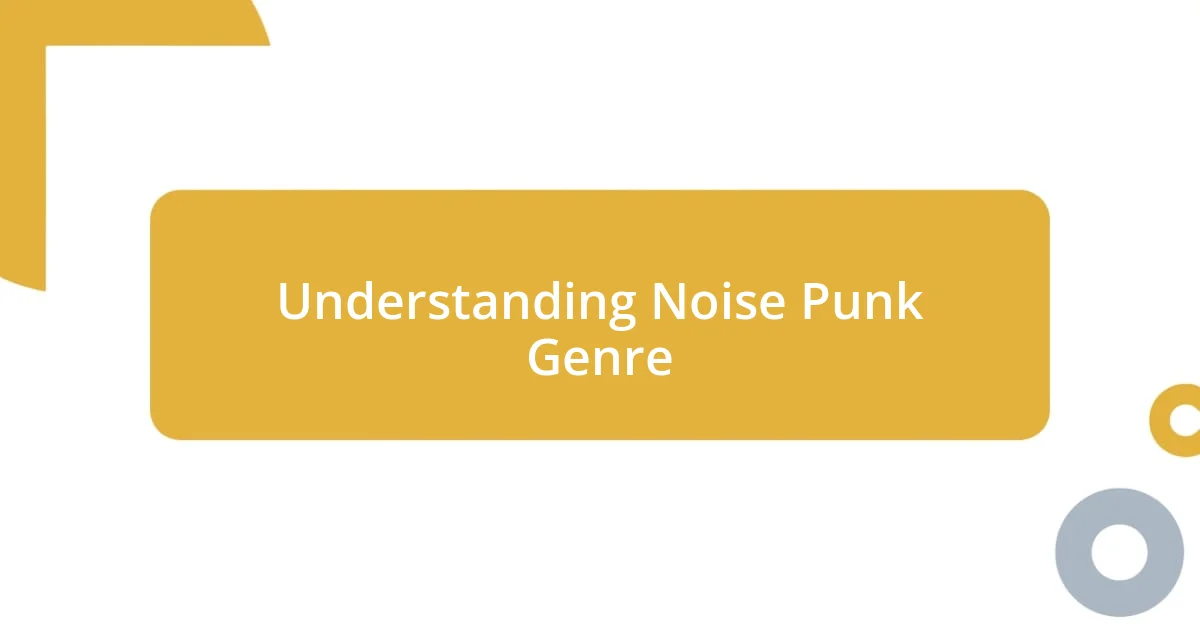
Understanding Noise Punk Genre
Noise punk, as a genre, embodies a raw, chaotic energy that mirrors the intensity of anger many of us grapple with. I remember the first time I blasted a noise punk band in my room; the cacophony felt like an explosion of pent-up frustration that resonated deep within me. Have you ever felt that rush? It’s almost liberating, isn’t it?
The hallmark of noise punk is its unrelenting sound, often characterized by distorted guitars, chaotic beats, and visceral vocals. I recall attending a live show where the band’s ferocity enveloped the crowd—it was an electrifying reminder of how music can capture and amplify our emotions. It’s fascinating how this genre challenges traditional structures and instead embraces imperfection.
For many, noise punk serves as an outlet for expressing feelings that are often hard to articulate. I’ve found that when the world feels overwhelmingly suffocating, turning to this genre can be cathartic. It’s like a sonic embodiment of my inner turmoil. Isn’t it intriguing how something so abrasive can also offer a sense of comfort and understanding?
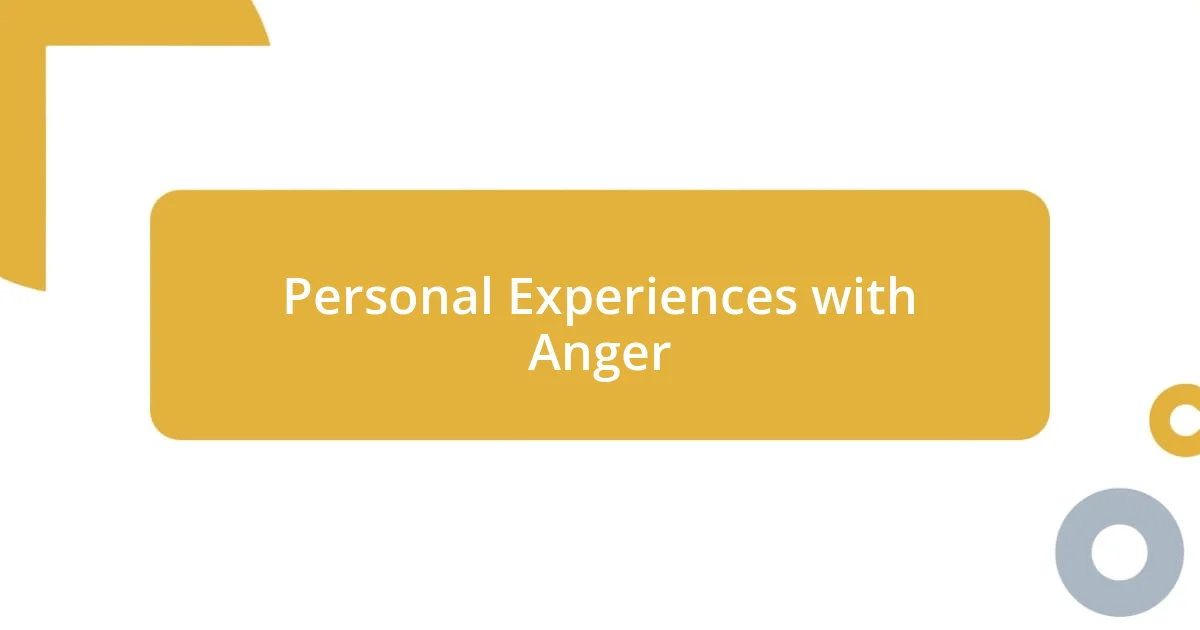
Personal Experiences with Anger
I’ve had moments when anger surged through me like a tidal wave. One particular instance that stands out is after a frustrating argument with a friend. In that moment, I sought refuge in my headphones, cranking up the volume on a noise punk playlist. The moment that first chord hit, it felt as if my anger transformed into unbridled energy that matched the music’s intensity. It was as if the brutal sounds gave voice to what I struggled to express.
Attending a noisy punk gig can be a healing experience for my anger. I vividly remember jumping into the mosh pit, completely immersed in the madness as I let go of my frustrations with every shove and slam. The way the music rang out—raw and unfiltered—allowed me to connect with others around me who felt similar emotions. Have you ever found solace in a chaotic environment? It’s almost like a collective therapy session where the adrenaline rush drowns out your worries.
In quieter moments, I sometimes reflect on how anger intertwines with creativity in noise punk. When I felt stuck artistically, I often turned to writing lyrics inspired by those raw emotions. It became a cathartic process, where each line unleashed pent-up thoughts swirling in my mind, transforming fury into art. It’s fascinating how such moments can shift one’s perspective and fuel personal growth.
| Experience | Emotion |
|---|---|
| Listening to noise punk after an argument | Frustration turned into empowerment |
| Mosh pit at a live show | Release and connection |
| Writing lyrics inspired by anger | Transformation of feelings into creativity |
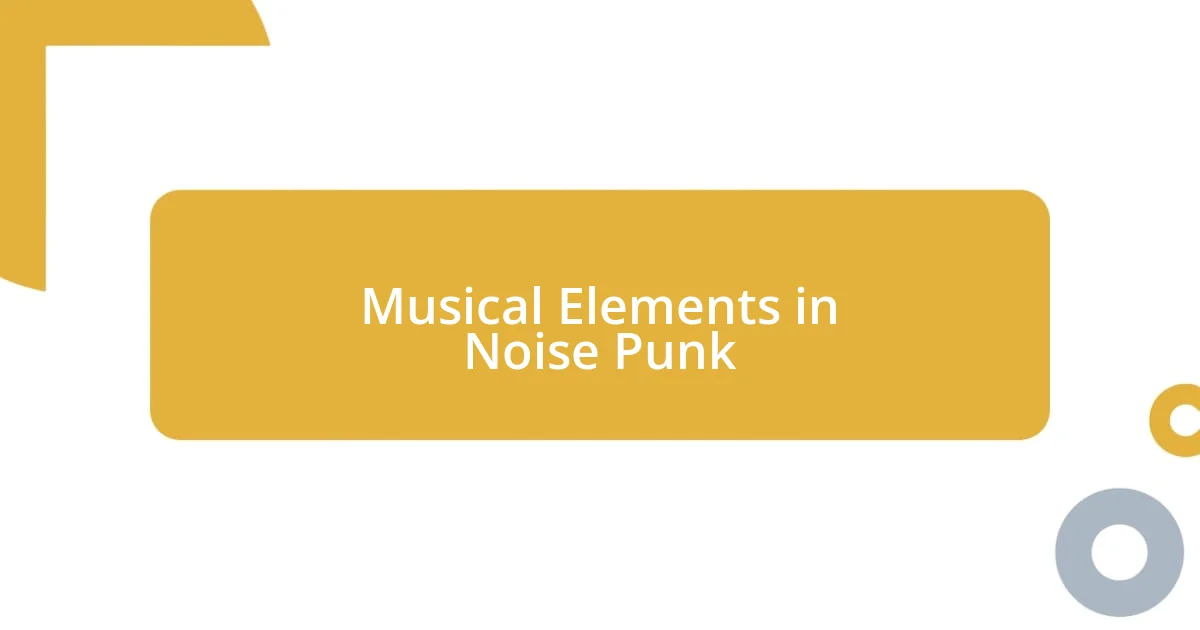
Musical Elements in Noise Punk
The musical elements in noise punk create a unique soundscape that not only reflects anger but also invites listeners to engage deeply with their emotions. For me, it’s like diving headfirst into a storm where the instrumentation — often chaotic and dissonant — becomes a powerful reflection of inner turmoil. When I first heard the detuned guitars screeching over relentless drum beats, I felt an instant connection. It wasn’t just music; it was an experience that mirrored the chaos of my mind.
Here’s a closer look at some defining musical elements of noise punk that contribute to its raw intensity:
- Distorted Guitars: Typically laden with fuzz and reverb, these guitars create a wall of sound that feels palpable and overwhelming.
- Pounding Drums: The drums often play in short, explosive bursts, adding to the urgency and frenetic energy of the music.
- Unrefined Vocals: Often shouted or screamed, the vocals serve as an emotional release, expressing anger and frustration in a visceral manner.
- Unpredictable Song Structures: Shunning traditional forms, noise punk embraces abrupt changes and chaotic elements that keep listeners on their toes.
- Feedback and Noise: The use of feedback and ambient noise layers adds an abrasive quality that heightens the overall intensity of the music.
Every time I blast my noise punk playlist, I feel like those elements become intertwined with my emotions, creating a visceral cathartic experience. I remember one evening when a friend and I were decompressing after a long week. As we cranked up the volume, the layers of sound washed over us, transforming the room into a tempest of emotion. It was in that moment, surrounded by distorted riffs and booming drums, that I felt a sense of liberation as if the music had unlocked something inside me, allowing cluttered thoughts to finally flow freely. This is the power of noise punk: it channels raw emotion through its defining musical elements, providing a visceral vessel for our struggles.
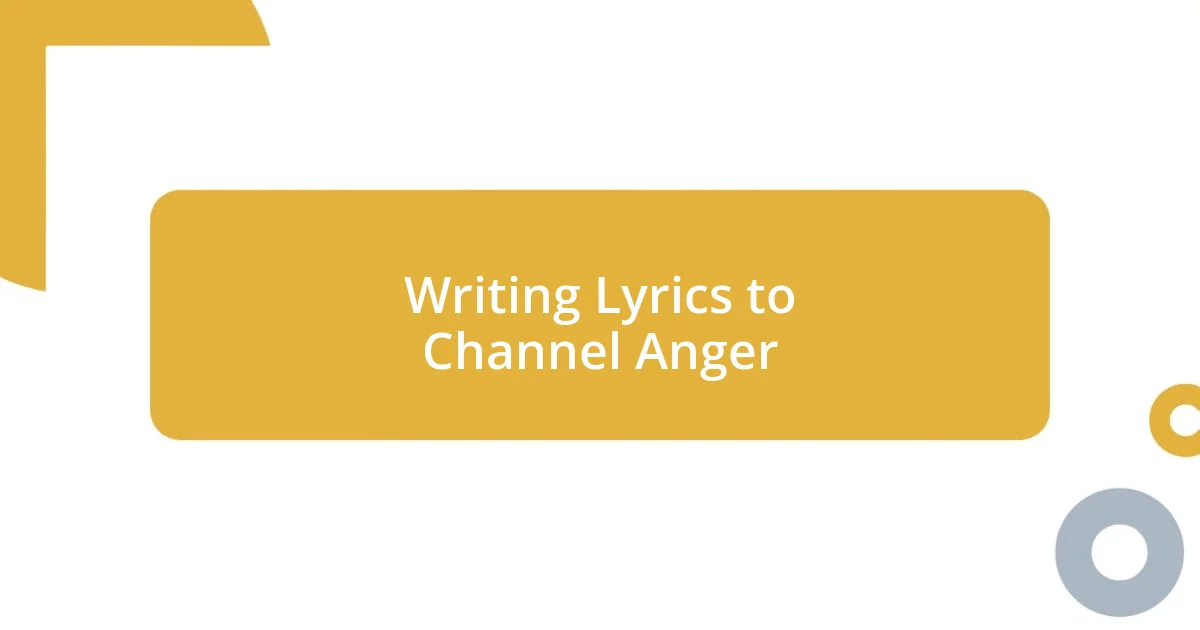
Writing Lyrics to Channel Anger
Writing lyrics has been a vital outlet for me to channel my anger into something tangible. There were times when I felt overwhelmed, as if emotions were swirling around without any direction. One evening, fueled by frustration and a desire to express myself, I poured my heart into a page. Each line I scribbled felt like an act of defiance, transforming my inner turmoil into raw, unfiltered expressions of rage. It’s almost like crafting a lifeline—something that helps navigate those stormy feelings.
The lyrics come alive when they reflect genuine experiences. I remember a specific moment when a friend abandoned me during a critical time. The intensity of that betrayal seeped into my words, creating lines that were part manifesto, part catharsis. I wrote about feeling like an outsider, encapsulating the isolation that often accompanies anger. Have you ever captured a moment of anger in writing and felt an unexpected release? It’s as if the act of translating emotion into words granted me a sense of control over an otherwise chaotic situation.
In my experience, the beauty of writing lyrics is not just about expressing anger; it’s also about creating a connection with those who hear them. The right words can resonate with others, making them feel seen and understood. I recall sharing my lyrics with friends, and their reactions felt validating. It was incredible to see how my personal struggles linked to theirs. Through this shared vulnerability, we created a communal experience, transforming individual anger into a powerful collective voice in the noise punk scene.
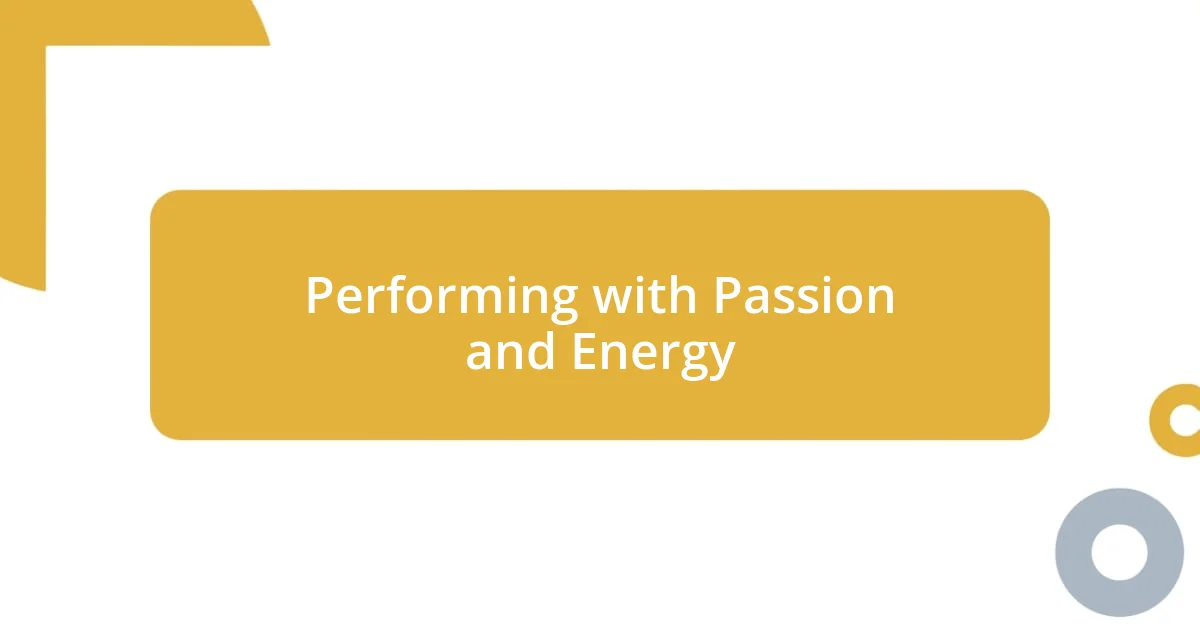
Performing with Passion and Energy
Performing in the noise punk scene is an electrifying experience. When I step on stage, I can feel the adrenaline surging through my veins, and it’s as if all my pent-up frustration transforms into raw energy. I remember one gig where the crowd was absolutely wild; my heart raced as I screamed into the mic, the distorted guitars screaming back at me. Have you ever felt that rush of energy in a live performance? The way the audience responds brings an unparalleled intensity that fuels my passion even further.
The physicality of performance is just as crucial as the sound. I use every part of my body to convey the emotion behind the music—jumping, screaming, even throwing myself into the crowd. I recall one unforgettable night when I dove into the throng, surrounded by fellow fans, feeling their passion colliding with mine. In that moment, the noise wasn’t just coming from the instruments; it was an overwhelming rush of collective angst and joy. It’s a cathartic release that goes beyond just expressing anger; it’s about connecting with a shared human experience.
Energy on stage is contagious. I’ve noticed that when I give it my all, the audience mirrors that enthusiasm, resulting in a feedback loop of passion. There’s a particular thrill in seeing someone in the front row lose themselves in the music, arms flailing and face contorted in pure emotion. It makes me wonder: how can one piece of music evoke such powerful reactions? This interplay of performer and audience creates a sacred space where anger turns into empowerment, transforming individual feelings into a communal celebration of defiance and freedom. It’s this very experience that solidifies my love for performing in the noise punk scene.
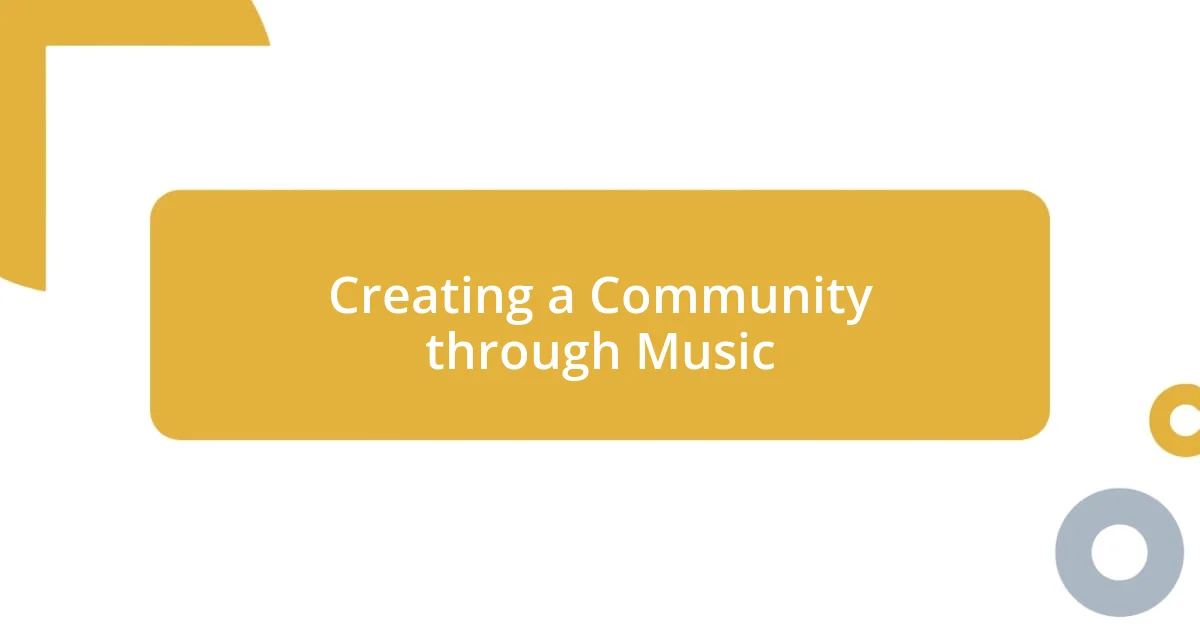
Creating a Community through Music
Music has a unique way of bringing people together. I vividly remember a small basement show where the air was thick with anticipation. As the first chord struck, the crowd erupted, and in that moment, I felt an unspoken bond with everyone around me. It’s fascinating how shared energy can create a sense of belonging, don’t you think? Each scream and thrash resonated with the collective anger we felt, transforming a simple performance into a rallying cry for unity.
Through music, we often find common ground that transcends our individual experiences. I once met a fan after a set; she approached me with tears in her eyes, sharing how my lyrics had reflected her own struggles. In that moment, I realized that my anger wasn’t just mine anymore—it became a thread weaving through our stories, stitching us together in a tapestry of shared pain and resilience. It’s incredible how one song can spark conversations that might never happen otherwise. Have you ever connected with someone just because of a single piece of music?
What really drives the community is the idea of mutual support we foster within our scene. During jam sessions, I’ve seen complete strangers come together, laughing and sharing their own tales of frustration while we collaborated on new riffs. That collaborative spirit is vital—it turns the harshness of our individual feelings into something beautiful and collective. In my experience, creating music together becomes a form of therapy and empowerment, reinforcing the notion that we are never alone in our struggles. Isn’t it amazing how music has the power to transform pain into something that unites us all?
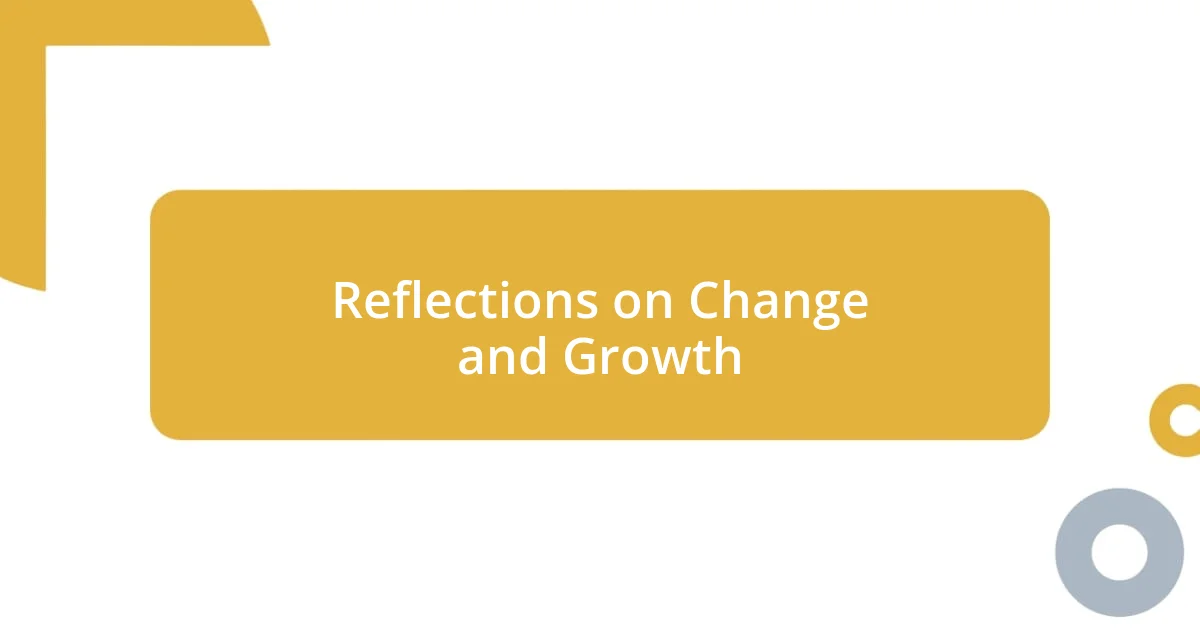
Reflections on Change and Growth
Looking back, I can see just how much I’ve changed through my experiences in noise punk. Each performance has taught me a lesson—not just about expressing anger, but about embracing my emotions fully. I remember struggling with feelings of inadequacy; then, during a particularly chaotic set, I screamed my fear into the mic. It was liberating. That moment felt like a breakthrough for me. Have you ever experienced a catharsis that shifted your entire perspective?
Growth isn’t always comfortable, and I’ve faced my fair share of challenges. I recall a time when my band faced criticism, and it stung deeply. Instead of retreating, I leaned into the discomfort, using it as fuel for our music. This led to a series of tracks filled with anger and defiance. The irony? That negativity transformed into something meaningful—each song became a powerful statement, not just for us, but for anyone who felt marginalized. Isn’t it wild how adversity can spark creativity?
Through these ups and downs, I’ve learned that change is often a series of small steps. I still remember my first gig, where I was nearly paralyzed with anxiety. Now, I thrive on that initial tension because it reminds me of how far I’ve come. Every scream, every chord change, epitomizes my journey of self-discovery. Change never stops, does it? It’s a constant cycle of growth that keeps me pushing the boundaries of my music and my emotions.
